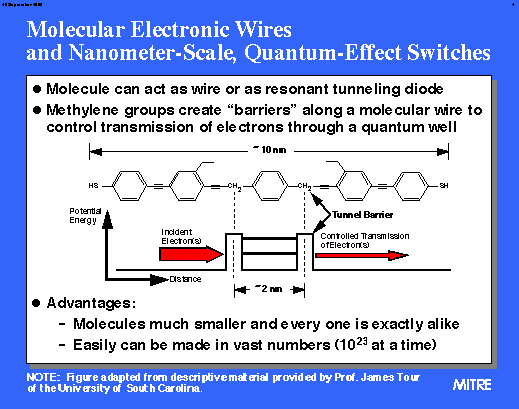Molecular-Scale Electronics
and Molecular Quantum Dots
In the early 1970's, two farsighted scientists, Ari Aviram and Mark
Ratner, began to envision electronic circuit elements made from single
molecules and to describe in detail how they might function. This was the
origin of the field of molecular electronics, now sometimes called "molecular-scale
electronics."
It has been observed in experiments and shown
theoretically that reducing the dimensions of a quantum dot
raises the effective operating temperature of the electron confinement device.
Present day quantum dots are large enough (approximately 1-10 microns long and
wide) that they require cooling with liquid helium or, at least, liquid
nitrogen, to cryogenic temperatures. However, for a practical technology with
widespread applications based upon such quantum-effect devices, it will be
necessary to achieve room temperature operation. This requirement implies that
it is necessary to invent and manufacture molecular-scale quantum dots that are
only approximately 1 to 10 nanometers in linear dimension. Such a quantum dot
would probably be constructed as a single molecule--i.e., a molecular quantum
dot. Molecular quantum dots are one example of the next-generation
technology known as molecular-scale
electronics.
In another example, Professor James Tour
of the University of South Carolina and Professor Mark Reed of Rale
University are collaborating on the chemical synthesis and testing of molecular
wires. These operate by allowing electrons to move nearly ballistically
along the length of a chain of ring-like chemical structures with conjugated
pi-orbitals. It has been suggested by Tour and by others, that it may be
possible to insert chemical groups of lower conductance into such a molecular
wire, creating paired barriers to electron migration through the chain. Such
barriers might create a molecular
quantum-effect device that would function in a fashion similar to
solid-state resonance
tunneling devices (RTDs) that already have been fabricated, tested, and
applied in prototype quantum-effect logic.
A group at Purdue University
has applied wires of the type invented by Tour as one element of a much more
complex, heterogeneous extended structure that functions as a molecular
electronic circuit array.
Molecular Resonance Tunneling Devices
Click
to zoom vugraph larger

Note: Figure in vugraph devised from descriptions in the work of
Prof. James Tour of the University of South Carolina.
Molecular Scale Electronics
Return
to Potential Nanoelectronic Two-State Devices Page
NOTE: Links highlighted on this page are provided as sources
of additional information. In some instances they will lead to Web sites not
maintained by The MITRE Corporation.
If you have comments, questions, suggestions, or contributions for this
page,
please send e-mail to mailto:%20nanotech@mitre.org
 Return to THE
Nanoelectronics Home Page
Return to THE
Nanoelectronics Home Page

